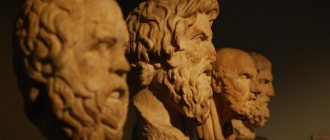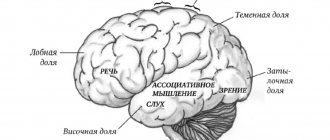Basic provisions
A white object, even in the dark, will be white. Because the person knows him that way.
The departing car, although it will shrink, will remain large in perception. Even if there is already a grain of sand in sight.
Without constancy of perception it would be difficult. Objects and people would seem something new to us. The person could simply turn in the other direction and would no longer be recognizable.
Objectivity of perception
This is the ability to perceive the world not as a set of individual elements, but as a whole.
It develops throughout life. I. Sechenov believes that its development occurs in the process of the child’s contact with objects.
Objectivity develops through motor skills:
- movement of hands and fingers when feeling objects;
- movement of the eyes when highlighting the outline of an object and “feeling” it from a distance;
- turning the head;
- other movements.
Perceptual process
Awareness of the world through the work of the senses.
Depending on which organ plays a role, they are divided into visual, auditory, olfactory and others.
The formation of a perceptual image consists of the following phases:
- Detection. The stage at which a person distinguishes an object from the background, but cannot yet reason about its characteristics.
- Discrimination. The stage at which a person can separately perceive nearby objects.
- Identification. The stage at which a person fixes properties and assigns them to a certain class.
LiveInternetLiveInternet
Wednesday, February 16, 2011 22:41 + to quote book 19. Constancy and objectivity of perception. The role of attitude and motivation in perceptual processes. Constancy of perception is the property of a perceptual image to preserve certain phenomenal characteristics unchanged under changing conditions of perception. Types of constancy: 1. Constancy of form. 2. Constancy of size 3. Constancy of magnitude 4. Constancy of color 5. Constancy of motion Procedure for identifying constancy: 1. There is a standard stimulus, the parameters of which are unchanged. 2. There are a number of variable stimuli that vary along the measured parameter. 3. The subject is instructed to select a variable stimulus so that it looks the same as the standard one. How to choose a variable stimulus? Constant coefficient - K = VP/RP (ratio of the amount of compensation performed to the amount of compensation required) - measured in angular inclinations (degrees). V – Perceived magnitude of a variable stimulus, at which it is perceived as identical to the standard one. R – Real value of the standard stimulus. P – Projection value (the imaginary value of the variable stimulus that the subject would choose if he were to compare the standard and variable stimuli based only on the parameters of their retinal images). With complete constancy K=1, i.e. V=P, if K=0 is constant, i.e. orientation occurs only to the retina (without signs). An experiment on the innateness of constancy. In animals, size constancy is not innate. An experiment was conducted with rats that were raised in the dark, and then they were given the task of running along the corridor at the end of which a larger circle was burning, and at the moment when the rat left the starting area and began to run, the circles went out. The rat learned to run towards a larger circle, and then this circle was removed so that it looked like a small one - the rats ran back and forth. And when the larger circle was removed so far that it appeared smaller, the rats began to run towards the smaller circle, which seemed larger. Newborn babies (Skinner). Constancy of perception of magnitude. They tried to develop a conditioned reaction in a 6-8 week old baby to the presentation of a cube with a side of 30 cm and located at a distance of 1 m (when the child turned his head, he received encouragement). This object was then changed and no more reinforcement occurred and the frequency of head rotation was recorded. When a cube with a side of 30 cm is presented. at a distance of 3 m the baby often turned his head, but less often than in the first case. When a cube with a side of 90 cm was placed at a distance of 3 m, the baby turned his head much less often. The child sees a cube with a side of 30 cm at a distance of 3 m in the same way as when the same cube was placed at a distance of 1 m during training, although the size is visible. angle decreased. An experiment on the constancy of visible shape. 50 subjects were presented with 2 rectangles from a distance of 1.5 meters: a reference and a measuring rectangle. The reference one had parameters of 1 meter by 1 meter and was always presented tilted at the alpha angle. The meter always had the same orientation, but we changed the shape: its height could increase and decrease. The subject was asked to adjust the height of the meter so that the visible shape of the meter was identical to the visible shape of the standard. Katz's experiment on color constancy. Two samples of white color are presented on a white background, but are separated by a partition so that the light from a lamp placed on the side illuminates the background on both sides of the partition non-uniformly. One of the sides is taken as the standard. The subject must select a color on the second side that is equal to the standard. Usually they choose a gray color, which is slightly darker than the standard one. That. the tendency towards constancy is evident. Nuclear-constant theory of constancy of perception Boring Boring proposed to call the size of the retinal image of an object a nuclear stimulus, and all other proximal stimuli (signs of perception of certain conditions in which a nuclear variable is presented), which supply information about absolute distance and allow one to compensate for changes retinal stimulus – contextual stimuli. The apparent magnitude is determined by the balance between nuclear and contextual stimuli. f я, к). The fewer contextual stimuli, the more dominant the nuclear stimulus. Holway and Boring's experiment In one corridor, at a distance of 3 meters, there was a stimulus being compared - a light spot, the size of which the subject could change. In another corridor, at a distance from 3 to 36 meters, a similar spot was presented - it was a standard stimulus, the dimensions of which changed along with the distance, so that it always had the same angular size, equal to 1º (this is the specificity of the experiment). The subject was asked to select the size of the stimulus being compared so that it was equal to the standard one. 4 options: 1) binocular vision conditions (head movement + normal lighting); 2) monocular observation; 3) the subject makes a comparison through an artificial small pupil (no eye and head movement + monocular motor parallax disappears); 4) darkened room (lack of light - absence of the last sign of depth). Results: 1) direct (1); the effect of superconstancy associated with some overestimation of remoteness; 2) direct (2), the perception of distance was still good, the obtained values are still in accordance with the law of constancy; 3) the results came even closer to the law of visual angle - straight line 4. The law of constancy would take place in the case of 100% constancy; law of visual angle – in case of complete absence of constancy. Conclusion: The fewer contextual stimuli, the more dominant the nuclear stimulus. Studies of the constancy of perception within the framework of the ecological approach of J. Gibson. The criticism of the other theories was as follows. That they were all tested within the framework of a laboratory experiment + in this theory there is no concept of “sign” and the identification of 2 variables. Constancy of perception is a phenomenon of direct perception, and not a process of two variables as in Boring. Direct perception of constancy means that in natural conditions there are invariants of the structure of the light flux, which indicate that only perceptions change, but the properties of perception do not change. What invariants exist that indicate the constancy of the value 1. The number of obscured texture elements (size constancy). The ground is uniformly textured everywhere + texture density gradient. No matter how far away an object is, it intersects or obscures the same number of texture elements. This number is an invariant relation that a person extracts to perceive constancy. Example with balls obscuring tiles. 2. Horizon line (constancy of size). It never moves and is the reference frame for all optical movements. The relation in which the horizon divides objects is invariant. Thus, equal objects are divided on the horizon line in equal proportions. An example with pillars going into the distance. 3. The relationship between angles and plane (shape consistency). When you tilt a rectangle, the planes tilt, but the sum of the angles remains the same. Ames' Theory of Perceptual Equations The criticism of the kernel-context theory was that: 1) it operates when K = 1; 2) constancy can change without reducing features. sometimes this greatly depends on the instructions to the subject (for example, they ask him to focus on a real sign). The phenomenon of constancy indicates that the proximal stimulus is not the only determinant for the visual image. Consequently, there are phenomena that do not fit into the scheme: distal stimulus → proximal stimulus → visual image. Between the distal and proximal stimuli comes our subjective assessment. Constancy is not formed at the retinal level (here P is equal to a constant). The conversation is about the relationship between subjective quantities (i.e., visible parameters are measured, not retinal parameters). The formation of an image proceeds as an initial hypothesis, which is then verified by a perceptual equation. Ames's room. The room has a trapezoidal shape. If 2 people of equal height stand along the back far wall, then the angular value of the one who is further away. It will be 2 times less than others. But with special. Selected signs of remoteness create the illusion that the room has a regular rectangular shape, i.e. the apparent distance of these people is perceived as the same. The phenomenon is that the person in the far corner appears to be half the size. There are invariant relationships between magnitude and distance that are uniquely determined by the proximal magnitude of the stimulus. Let us introduce the following notations: PV – physical magnitude of the object (distal stimulus), FU – physical distance of the object, VP – visible magnitude VP – visible distance So, the invariance of the relationship between the visible magnitude and the apparent distance is expressed by the following formula: α = K* VP/VU where K is the proportionality coefficient. Consequences of this formula (one of the 3 variables is fixed at one level, the other varies in number, the third is studied). 1. The apparent size of an object is proportional to the apparent distance if the proximal size of the stimulus is constant: BB = K*VU, if α = const Emmert’s Law: the size of the afterimage is proportional to its absolute distance. 2. At a constant apparent distance, the visible value should change in direct proportion to the visual angle: BB = K*α, if VP = const. Discrimination of objects at the same distance (when reducing the signs of distance, it seems that all objects are on the same plane at an approximate distance of 1.5: 2.5 m). 3. If the apparent size of the perceived object is known, then the apparent distance will be inversely proportional to the angle of view: ВУ′= К*αˉ¹, if ВВ = const. Ames experiment with playing cards. The subjects were presented with 3 brightly lit playing cards under conditions of complete reduction of distance signs. Each card was placed at the same physical distance from the observer, but the sizes of the cards were different: one was normal size, another was twice the size, and the third was half the size. The subject assessed the distance of these maps. It turned out that the subject believed that the larger map was twice as close, and the smaller one was twice as far as the normal map. Currently, 15 perceptual equations are known to be written. Objectivity - our images of perception contain definitions. cognitive information, objects are recognized as having def. physical properties. Aspects (Logvinenko): a) all images are images of really existing objects (reality); 2) everything that we perceive, we understand (meaningfulness); 3) a person experiences the image as externalized (objectivity); 4) unity of data received from the senses (polymodality). Types of optical distortions: 1) inversion (change in the orientation of the retinal image - top-bottom), 2) reversion (change in the orientation of the retinal image - right-left), 3) inversion (inversion + reversion), 1) displacement of the retina. images on def. angle, 2) change in color, 3) change in the sign of disparity (depth reversal), 4) distortion of the shape and curvature of the surface, 5) time distortion (delay in the perception of information). The problem of perceptual adaptation to the conditions of inverted vision Stretton: day 1 - the phenomenon of doubling the world (orientation to past skills, but memory images do not correspond to perceptual images); Day 2 - an attempt to create new motor actions, which correspond. to a new distorted world; Day 5 - motor adaptation (actions become less conscious). Day 6 - the world is perceived as stable, day 8 - after taking off the glasses for several hours there was a feeling of the unreality of the world, some fragments of images seemed inverted. Analog. experts Evert (no adaptation occurred), Kohler (observed a high degree of adaptation, including motor, for some time after removing glasses the world was perceived upside down), Logvinenko (observed a sharp decrease in constancy during inversion; adaptation was often incomplete and unstable) , Snyder (observed the following effect: an attempt to analyze the visible led to the destruction of adaptation). Studies of pseudoscopic perception Disparity as a phenomenon is the doubling of any object. K lies outside the fixation zone. It can be calculated quantitatively - this is the difference between the angles of convergence of both eyes. It can be negative (the object is located closer to the fixation point) and positive (the object is located further than the fixation point). A pseudoscope is a device that can change the sign of disparity. In this device, images change in depth: points located closer are perceived as lying further away. Kompaneisky did this. Experiments on changing the sign of disparity (pseudoscopic vision). The subject, looking through a pseudoscope, sees a reversal of depth (but not immediately, this must be learned). Kompaneisky identified factors influencing the speed of circulation: 1) necessary. focus on the parts rather than the whole; 2) required distance yourself from the objective characteristics of objects, i.e. look at objects as if they were unfamiliar. Phenomena: 1. Disparity can compete with overlap (overlap is stronger); 2. Well-known objects cannot be accessed at all. (Stolin's research: the forearm rotates, but the hand does not; a human face or mask cannot convert). Rule of plausibility (Stolin) - pseudoscopic transformations of images of objects occur only to the extent that they are permissible from the point of view. the knowledge a person has about objects and the properties of these objects (if we change the sign of disparity, then we find in past experience something that could have been in such a state. Next, we attribute objective content based on this state). Stolin’s experiment: 1. The subject observed a bowl of colored liquid from above. In order for depth reversal to occur, the subject had to perceive the thing in the bowl not as a liquid, but, for example, as metal. plastic, jelly. Then a solid object was thrown into the bowl - appeared. circles on the water. If before this the subject perceived the liquid as jelly, then everything was fine, but if he initially perceived it as metal or plastic, then the bowl is again perceived as normal. Conclusions: 1. Images are transformed according to special rules, and not according to the laws of disparity. 2. Rule of likelihood. 3. This is clearly a subject-oriented process of perception (even contrary to the objective laws of disparity). Studies of the formation of skin vision in the blind. To what extent does a person need the eye to form images? An attempt to swarm artificial vision. This is possible with the help of a special device. which was attached to the head and had a def. sensors (retina model). For 3 weeks, people were taught how to navigate using this device. Results: 1) taught to perceive the movement of objects; 2) distinguishing shape (for example, circle and square); 3) constancy of the size of objects; 4) perception of relative distance: further is what is above the field of view; 5) formation of visual motor coordination. Studies of perception at school “New Look” Installation - selective focus and bias towards the process of perception. J. Bruner. Perception is subordinate to behavior. Its function is to provide people with only the information they need. to solve behavioral problems. Perception, therefore, is selective. A person perceives only that information that is necessary, important, and valuable to him. On perception, i.e. influenced by subjective variables such as needs and values. Postman studied the perception of coins of different denominations. Two series: 1) children evaluated coins of various denominations (1, 5, 10, 25 and 50 dollars) from memory, comparing them with a round gap; 2) they evaluated the actually presented coins. way: an op coin was placed in the child’s palm. denomination, and he had to select a light spot on the wall the same size as the coin; 3) in the control group they assessed not coins, but circles. In the results above, the size of the coins, not the circles, was estimated. Moreover, as the denomination of the coin increased, the revaluation value was significantly higher. Modification of the experiment: creation of two groups of children – “poor” and “rich”. Children from poor families overvalued coins to a greater extent. His conclusion is that not only the ratio is important, but also the attitude towards the stimulus; a process that comes from the subject himself; The stronger the individual’s need for something, the more significant the behavioral determinants of perception. Hypotheses: 1) the more social. the value of an object, the more it distinguishes it from others; 2) the stronger a person’s need for an object, the more he distinguishes it from Dr. Hudson. Cross-cultural studies of reproduction. Africans do not understand the conventions of imagery. with natural for Europeans. Draw a person, pick him up. on the stairs - in Europeans. everything is OK, but they are African. - one leg is shorter. The task “to draw a cow in profile” is for the Europeans. everything is OK, but Africans. - 4 - a combination of a side view and a front view (4 legs, 2 horns...) Conclusion - Europeans draw what they see, although they know that in fact this is not true; and Africans - what they know. Bruner, Tolmen considered perception as a process included in the overall complex of human behavior. Bruner: Perception is a categorization process based on past experience. The categorization process is phenomenon. Selectively directed, it is included in the context of the behavior of the person. Perception is not just representation, but the construction of a “model of the world”; This is the decision -making process. Thus, perception supplies the subject with that information, which is non-Cho. To solve the tasks of behavior. The selectivity of perception depends on the various degrees of readiness of the category for perception (the individual approaches the situation of perception with CR. Expectations, assumptions regarding how to interact with the perceived object). Any category has perceptual readiness. Readiness for use - installation. The degree of readiness depends on situational (probability of behavior at the moment) and personal (my condition) determinant of behavior. So, the more readiness, the more: 1) less information is necessary to attribute the object to this category; 2) a wider set of characteristics of the “entrance”, which will be accepted as corresponding to this category; 3) It is more likely that other categories, which are the same corresponding to the “entrance”, will be frozen.
Cited 1 time
Like share
0
Like
- I liked the post
- Quoted
- 0
Saved
- Add to quote book
- 0
Save to links
Liked
0
Perceptual side of communication
The process in which people, through communication, perceive each other and establish contact.
A minimum of two people are involved. Ideas about the intentions, feelings, thoughts of the interlocutor and oneself are created.
People become aware of themselves and others through the following mechanisms:
- knowledge and understanding of each other;
- self-awareness in the process of communication;
- in communication, predicting the future behavior of a partner.
Perception and its properties
Perception in its essence refers to a complex mental process, which consists in a holistic reflection of phenomena and objects acting at a certain time on the senses. Conventionally, perception is represented as a combination of thinking, memory and sensations. Experts identify the following properties of perception:
- objectivity;
- integrity;
- constancy;
- generality;
- selectivity;
- structure;
- meaningfulness.
We propose to consider each of the above properties in more detail.
The role of attitude in perceptual processes
Attitude affects people. When a person unconsciously reacts in a habitual way to information or people without analyzing it.
Settings are divided into 3 dimensions:
- Cognitive dimension - certain opinions, thoughts, beliefs about something or someone.
- The affective dimension is the presence of negative or positive emotions towards a person or information.
- Behavioral dimension – preparedness for behavioral reactions that correspond to a person’s beliefs.
Settings are formed:
- under the influence of others. These could be parents, the yellow press, acquaintances and friends;
- based on past experience in repeated situations.
Constancy
The integrity of perception has a close connection with constancy, which should be understood as the relative independence of certain properties of objects from their reflections on receptor surfaces. With the help of constancy, we are able to perceive phenomena and objects as relatively constant in position, size, color and shape.
In psychology, constancy of perception is the stability of the acceptance of various properties of phenomena or objects that persist under various physical changes in stimulation: intensity of speed, distance, light, and much more.
The role of motivation in perceptual processes
Motivation
A reason that encourages action.
It can be guided by primitive factors. For example, hunger, cold. Or psychological needs for love, respect, recognition. Motivation plays a role in the desire for self-actualization.
For example, when feeling hungry, a person may read “lunch” instead of the word “shoes.” Carried away by ambition is a misheard phrase. An old example can be given: a person spends a long time in the desert and is tormented by thirst. After some time, he sees in the distance an oasis with clear and cool water.
Causal attribution
When considering the mechanisms of social perception, one should not ignore such a fascinating phenomenon as causal attribution. Without knowing or insufficiently understanding the true motives of another individual’s behavior, people, finding themselves in conditions of information deficiency, may attribute unreliable reasons for their behavior to him. In social psychology, this phenomenon is called “causal attribution.”
By looking at how people interpret the behavior of others, scientists have discovered something called the fundamental attribution error. It occurs because people overestimate the importance of others' personality traits and underestimate the impact of the situation. Other researchers have discovered the phenomenon of “egocentric attribution.” It is based on the tendency of people to attribute success to themselves and failure to other people.
G. Kelly identified three types of attribution:
- Personal. The reason is attributed to the one who performed the action.
- Objective. A cause is attributed to the object upon which the action is directed.
- Attribution related to circumstances. The cause of what happens is attributed to circumstances.
The observer usually resorts to personal attribution, and the participant, as a rule, attributes everything to circumstances. This feature is clearly visible in the attribution of success and failure.
An important issue in considering causal attribution is the question of the attitude that accompanies the process of perceiving a person by a person, especially in the formation of an impression of an unknown person. This was revealed by A. Bodylev through experiments in which different groups of people were shown a photo of the same person, accompanied by characteristics such as “writer”, “hero”, “criminal” and so on. When the installation was triggered, the verbal portraits of the same person were different. It was revealed that there are people who do not lend themselves to stereotypical perception. They are called selectively stereotypical. Having examined the mechanisms of social perception, let us now briefly talk about its effects.











